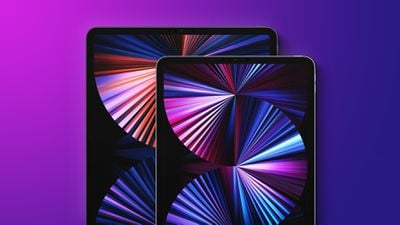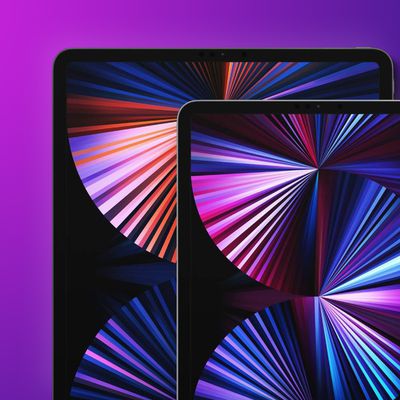Apple is developing OLED technology for the iPad, and the new displays are expected to come to the iPad Pro models as soon as March 2024.
This guide aggregates everything we know about Apple's plans for the OLED iPad Pro.
Sizing
Apple is expected to offer the first OLED iPads in sizes that are similar to the current iPad Pro sizes, providing one smaller 11.1-inch model and a larger 13.1-inch model. In the future, OLED iPad models could be as large as 15 inches, but Apple is sticking to smaller screen sizes for now.

Rumors suggest that Apple supplier BOE is developing OLED displays as large as 15 inches, which could be used for a larger-sized iPad. According to Bloomberg's Mark Gurman, Apple is considering iPads that exceed 12.9 inches, and in 2021, he claimed that larger sizes were a "couple of years down the road, but could be scrapped all together.
The OLED iPad Pro models could be much thinner than the current LED versions thanks to the new display technology. The larger 12.9-inch iPad Pro, for example, could be more than 1mm thinner.
- Current 11-inch iPad Pro - 247.6mm x 178.5mm x 5.9 mm
- Upcoming 11-inch iPad Pro - 249.7mm x 177.5mm x 5.1mm
- Current 12.9-inch iPad Pro - 280.6mm x 214.9mm x 6.4mm
- Upcoming 13-inch iPad Pro - 281.5mm x 215.5mm x 5.0mm
CAD drawings of the upcoming ~11-inch and ~13-inch iPad Pro models give us some insight into just how thin the tablets will be.


CAD drawings of unreleased Apple devices often leak out of Apple's factories in China and other countries because the information is so valuable to case makers. Case makers use these measurements to design cases for new products in order to be the first to market with a protective case for a new device size.


OLED Improvements
Compared to the mini-LED technology that Apple uses for the 12.9-inch iPad Pro at the current time, OLED will bring deeper blacks, faster refresh rates, and improved contrast.

With an OLED display, the brightness of each pixel can be controlled individually, which means TV shows, movies, and other content that uses high dynamic range lighting will look much more realistic and true-to-life than on a mini-LED display, depending on how high Apple can boost brightness. OLED displays are also known for having better viewing angles than LED displays, but this is of less importance on a tablet-sized device than something like a TV.
OLED displays are more efficient than mini-LED displays, especially with the dual-stack technology that Apple plans to use. We can expect improved battery life on the OLED-equipped iPad Pro models, and it could facilitate always-on display technology on the iPad.
OLED technology can have downsides like burn-in and issues with maximum brightness, but Apple is using technology that will mitigate these problems. Unfortunately, it could make the first iPad Pro models much pricier.
Apple is rumored to be aiming for "unrivaled" image quality, as well as a design that cuts down on the thickness and weight of the iPad display.
Other New Display Technology
Apple could also add a matte screen option that's similar to the Studio Display's nano-texture glass, which would be offered in addition to a standard glossy finish. The matte screen features -4° to +29° of haze and Apple could advertise some kind of blue light blocking technology to protect the eyes. Matte finishes on displays are often designed to minimize glare and reflections.
Apple is planning to cut down on the size of the bezels of the iPad Pro display, and the bezels could be around 10 to 15 percent thinner.
M3 Chip Technology
The iPad Pro models coming in 2024 are expected to feature the M3 chip that was first used in the MacBook Pro and iMac models. Built on a 3-nanometer process, the M3 chip has a faster CPU and GPU compared to the M2 chip in the current iPad Pro models.

Front-facing Camera
The upcoming iPad Pro's front-facing camera is expected to be positioned on the side of the device rather than the top, which would allow the camera to be upright when the iPad is positioned in a landscape orientation. The current iPad Pro has a camera that's at the top, so the camera is upright only when it is used in portrait mode.

A camera that is upright when the iPad is on its side in landscape mode makes sense for devices that are used with stands and keyboards, such as the Magic Keyboard. The change will let an iPad Pro attached to the Magic Keyboard remain in that orientation for FaceTime and other video calls.
Pricing
There have been multiple rumors suggesting the OLED iPad Pros will be more expensive, with the information varying on how much of a price increase we might see.

Right now, the 11-inch iPad Pro is priced starting at $799, while the 12.9-inch model with mini-LED display is priced starting at $1,099. A February 2024 report from DigiTimes claimed that the iPad Pro models could be up to $160 more expensive, but other rumors predict even higher prices. A March 2023 report from Korean site The Elec, for example, suggested that OLED displays will make the iPad Pro models much more expensive. The Elec says the 11-inch OLED iPad Pro could be priced starting at $1,500, while the 13-inch model could be priced starting at $1,800.
Costs are expected to increase due to the OLED panels, which cost more to source. Apple is using new production processes that have not yet been combined to create OLED panels of the required size. Apple wants a thin design using a tandem-stack design, a display manufacturing technique that improves display longevity and efficiency. Dual-stack construction can boost the lifespan of an OLED panel up to 4x, and it also results in higher brightness levels.
Samsung and LG Display are supplying panels for the OLED iPad Pro. Samsung is manufacturing the panels for the 11-inch model, while LG is making the panels for the larger iPad Pro.
MagSafe Charging
The next-generation iPad Pro could potentially include support for MagSafe charging.
Back in 2021, Bloomberg's Mark Gurman said that Apple was considering a glass back for the 2022 iPad Pro, allowing for MagSafe wireless charging capabilities. The 2022 iPad Pro models did not feature wireless charging, a glass back, or notable design changes, but it is possible that Apple tabled the feature for a future launch.
Apple could be planning for a glass-backed iPad Pro next year, which would support MagSafe and Qi-based charging. There is also a chance that the MagSafe charging for the iPad that we're hearing about refers to a Mac-like magnetic charger rather than an iPhone-style magnetic charger, but that remains to be seen.
Storage
Apple might offer up to 4TB of storage, which would be double the current 2TB maximum. Current iPad Pro models are available with 256GB, 512GB, 1TB, or 2TB storage capacities.
New Magic Keyboard
The revamped iPad Pro models with OLED displays will be accompanied by a refreshed version of the Magic Keyboard that includes a larger trackpad to make the iPad Pro look more like a laptop than the current model.
Apple Pencil 3
There have been rumors of a third-generation Apple Pencil with interchangeable magnetic tips, and if there is a new Apple Pencil in the works, it could come out alongside refreshed iPad Pro models.
Launch Date
Apple is expected to introduce the OLED iPad Pro models in April. There were rumors that the iPad Pro would launch on March 26, but that has been debunked, and we are not expecting to see new models until early in April.

























